PinotFile: 9.50 November 21, 2014
|
Bouchaine Vineyards: A Winery Steeped in Carneros HistoryBouchaine Vineyards is the oldest continuously operating winery in the Carneros district, dating back to 1934. The colorful history of Carneros and the Bouchaine Vineyards property is summarized here. The bold font entries directly refer to the history related to Bouchaine Vineyards. 1834 General Mariano Guadalupe Vallejo of Mexico government arrived in Sonoma to secularize Mission San Francisco Solano, the last of the 21 missions built in California. He also came to free the Indians and distribute the mission lands. Most of the land grants were awarded to Vallejo’s relatives or friends, and many were soon subdivided and sold for farmland, leading to the settling of Carneros. Late 1830s Carneros is maybe the second oldest vineyard area in Northern California when Jacob Leese plant a small vineyard on his Huichica grant. Rancho Huichica was deeded to Jacob P. Leese. It lay west of the Rancho Rincón de los Carneros crossing into Sonoma County. It comprised the bulk of the Carneros district and was used primarily for grazing, vineyards, and dairying. 1836 Nicolas Higuera granted the Rancho Rincón de los Carneros (roughly translated to “sheep corner ranch”) and Rancho Entré Napa where Napa City now stands. Higuera was the first to use Carneros for farming and grazing land. The location near the sloughs made it a popular spot to catch a train (Buchli Station) or a boat (Cuttings Wharf). 1840s Influx of American, German, French and Irish settlers who arrived by horse, wagon or foot, traveling through Carneros on the Sonoma Highway that connected Sonoma and Napa valleys. 1846 A group of American frontier settlers (Americanos living in the territory) headed by Major John C. Fremont became dissatisfied with the Mexican government and overthrew General Vallejo’s forces in the famous Bear flag Revolt. The revolt lasted 26 days and California was an independent republic for 25 days. A month later, in 1850, California was annexed by the United States and became the 31st state. 1847 Higuera and Leese began selling portions of their ranches to American settlers. Some land was turned into vineyards. 1848 Nathan Coombs founded the City of Napa on land given to him by Nicolas Higuera. 1849 Napa formed as one of the original 26 counties of California. 1850-1860s Stagecoaches traversed Carneros daily on the way from Sacramento to Petaluma. Farmers flocked to Carneros to raise cattle and sheep as well as to grow grains, pears, plums, apples and apricots. Schellville and Buchli railway stations were built to handle the flow of milk, grain, fruit, hay and cattle to San Francisco markets. 1850s Boon (a.k.a. Boone) Fly purchased the current Bouchaine property in the early to mid 1850s. Boon Fly farmed orchards on his land and was the first to grow grapes on the property. Boon Fly was born in Kentucky in 1810 and was the father of Camillus Sidney (Buck) Fly, a renowned frontier photographer. He photographed Geronimo’s surrender and his photographs are in the Smithsonian. 1856 Edward Stanly bought 1,600 acres of Higuera’s land. Upon his death, he willed the land to nephew Judge John A. Stanly. By 1895, Stanly had at least 300 acres of grapes on his Stanly Ranch, one of the largest vineyards in California at the time, including Zinfandel, Mataro, Pinot Noir, Cabernet Franc, Cabernet Sauvignon, Bedan and Tannet. Mid 1850s-1870s William H. Winter acquired over 1,300 acres of Huichica Rancho from Leese. By 1872, this was one of the largest vineyard holdings in Carneros (Talcoa Vineyards), and the first winery in Carneros, Winter Winery, was built. The wine industry thrived in Carneros. 1879 James Simonton, the new owner of Huichica Rancho, hired professor of viticulture George Hussmann to manage his Talcoa Vineyards and battle phylloxera. Hussmann eventually developed a resistant rootstock that helped save the Napa Valley wine industry. Late 1870s and 1880s Phylloxera devastated the Carneros vineyards. About 1900 Southern Pacific built a station near Boon Fly’s property called “Buchli Station,” on land owned by John M. Buchle (a.k.a. Bulchi). 1927 Johnny Garetto, an Italian winemaker, bought Fly’s property in 1927 and constructed a winery shortly thereafter on the land. He completed the winery and bonded it in 1934 (1935). Garetto’s winery was the first post-Prohibition winery to operate in Carneros. The winery survived Prohibition by reputedly bootlegging wine and making sacramental wine. Grapes were sourced from the Stanly Ranch. 1919-1933 Prohibition knelt a deathblow to the Carneros wine industry. 1942 Louis M. Martini bought 200 acres of the Stanly Ranch and with Harold Olmo began extensive Pinot Noir and Chardonnay clonal experimentation in Carneros. The research led to the UCD clone 108 for Chardonnay and UCD clones 12 and 15 for Pinot Noir. 1951 Beringer Vineyards acquired Garetto’s property and winery and used the property’s building for production and storage until 1981. 1960s This was a decade of new vineyard development by Beaulieu Vineyards and grower Rene di Rosa of Winery Lake Vineyard. 1972 Carneros Creek Winery established by Francis and Kathleen Mahoney, and partner Balfour Gibson. A winery was built in 1973. 1979 Acacia Winery debuted with Larry Brooks and Michael Richmond as winemakers. 1980s Hundreds of acres of vineyards planted in Carneros. 1981 Saintsbury founded in Carneros. Saintsbury was the first California winery to make Pinot Noir totally from Dijon clones.
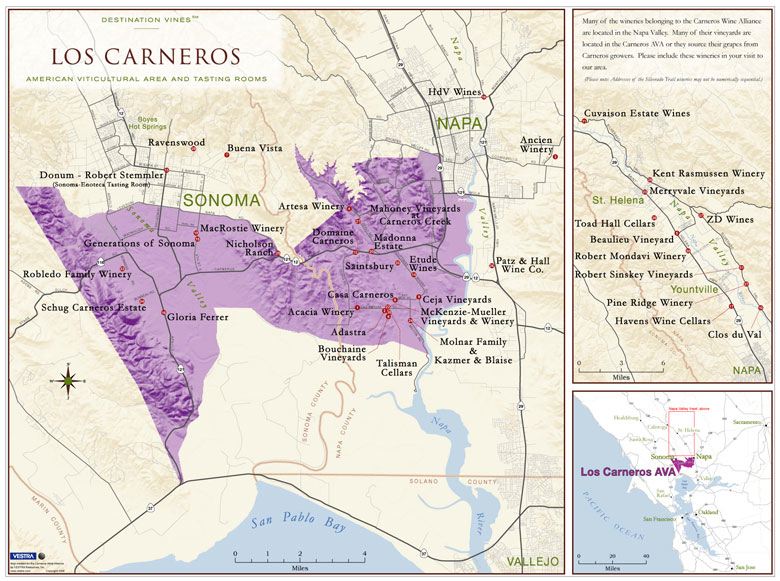 1981 The winery used by Beringer had fallen into disrepair and was sold along with the surrounding 30 acres to a Delaware-based partnership headed by Gerret and Tatiana Copeland. (Gerret Van S. Copeland is an heir of the DuPont family) The winery was renamed Chateau Bouchaine. Bouchaine, or bouchon, is loosely translated from the French meaning cork or a bouchaniere, that was an 18th century person who placed corks in bottles. The first winemaker was Jerry Luper who left in 1986. At the time, only a few winemaking pioneers realized the potential for Pinot Noir and Chardonnay in Carneros. Renovation of the property and dilapidated winery building began and continued for the next two decades. Huge redwood tanks were recycled as a new external facade and internal paneling for the renovated building. 1983 Carneros became an AVA. 1993 The Copelands bought out other partners and renamed the property Bouchaine Vineyards. Renovation of the winery reached completion in 1996. 1997 An additional 60 acres of contiguous land was bought including 2 small knolls that became icons of the Bouchaine estate and part of the label design. 2002 Michael Richmond, a veteran who co-founded Acacia Winery became the winemaker as well as overseeing continued vineyard planting and replanting. 85 acres of estate vineyards now surround the winery. Later, the assistant winemaker became Andrew Brooks, the son of Larry Brooks, the other co-founder of Acacia Winery. 2014 Bouchaine Vineyards is the oldest continuously operating winery in the Carneros AVA. References: Carneros Quality Alliance, Napa County Historical Society
On the Pinot Trail: Tasting at Bouchaine VineyardsI visited Bouchaine Vineyards on October 31, 2014, where I was hosted by winemakers Michael Richmond and Andrew Brooks. After a brief historical over view of the property, we headed into the winery for some barrel tasting of 2014 blending component and vineyard-designated Pinot Noirs while discussing at length the evolution of the winemaking process at this winery and the viticultural changes and goals. Bouchaine has the perfect combination of a wily winemaking veteran in Richmond, who still has a bit of a Texas drawl that reveals his upbringing, and a young enthusiastic talent in Brooks, whose childhood was steeped in the geography of Carneros winemaking by father Larry Brooks, the co-founder with Michael Richmond of Acacia Winery (photo below). Greg Gauthier, at one time the National Sales Manager and Winery Production Manager, was the third contributor, working alongside Richmond and Brooks in selecting yeast and barrels and helping to make decisions on when to harvest and management of the vineyards, but he is no longer with Bouchaine Vineyards.
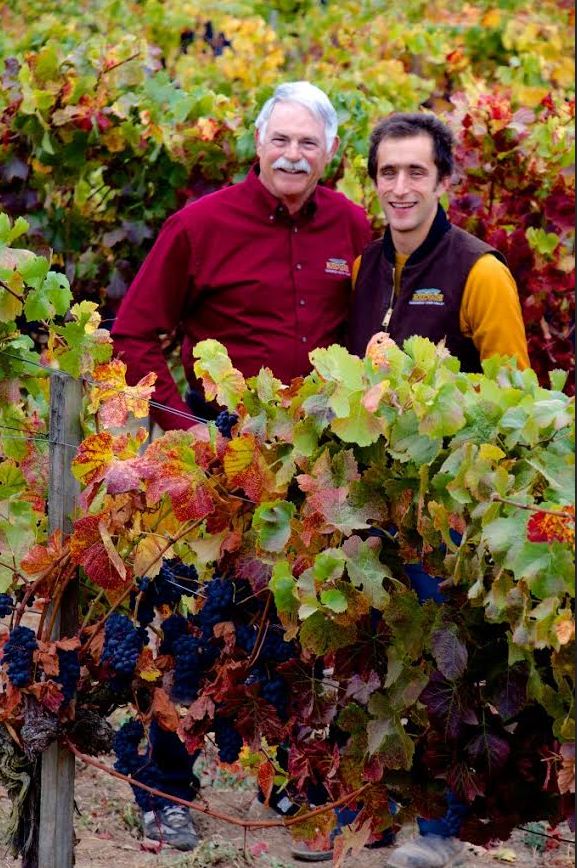 Michael began his career in wine at Freemark Abbey following an eighteen-month cross country bicycle tour adventure after college. He worked in all aspects of winemaking while attending courses in winemaking at University of California at Davis. In 1979, he co-founded Acacia Winery with Larry Brooks and considers this the onset of his winemaking career. Acacia was one of the first California wineries to feature vineyard-designated wines. Michael remembers, “We had all cast our lot with Pinot Noir, which was a much-maligned variety at the time. We dared to take on the doubting wine press.” Michael later helped launch the Steamboat Pinot Noir Conference held annually in Oregon. When Acacia was acquired by the Chalone Group in 1986, Michael spent several years as Chalone’s vice president of sales. He returned to winery life in 1993 to manage the new Carmenet Winery where he created the “Dynamite” Cabernet label. While at the Steamboat Pinot Noir Conference in 2002, he heard that the owners of Bouchaine were looking for a general manager and winemaker, and Michael felt a sense of destiny. Andrew is the son of the well-known Carneros winemaker, Larry Brooks. He grew up around vineyards and wineries and did not consider any occupation other than winemaking. After working at Domaine Carneros, he learned of an opening in the lab down the road at Bouchaine in 2007 and jumped at the chance. Michael groomed him for the winemaking job at Bouchaine, and he told me that Andrew, whose title is associate winemaker, essentially makes the wines now. Andrew admits that he has benefited greatly from Michael’s calm demeanor and critical optimism. Andrew notes, “Making truly great Pinot Noir is a lifelong challenge; to make a wine which is charming when it’s young but which ages gracefully, is one of the great challenges of winemaking.” Michael is quite humble while admitting his winemaking has constantly evolved throughout his career. When he arrived at Bouchaine initially, the protocol was to make the “richest, darkest, biggest” wines he could, featuring plenty of fruit and very little savory component. This was a response to criticism that the wines had been “wimpy.” He used smoky, well-toasted oak barrels that were made fashionable by the late Henri Jayer of Burgundy, giving the wines a bacon fat character. The problem was the wines were interpreted as having smoke taint by consumers who had never tasted Jayer’s wines, and the stylistic goal was lost on them. Michael says that the past several years have seen a gradual change in the Bouchaine Pinot Noirs. Barrel regimens have been instituted to emphasize sweet spice rather than toast. He has backed off extraction slowly and placed less emphasis on picking very ripe fruit. The goal is to uncover the ethereal side of Pinot Noir, find more balance, and uncover vineyard expression. It is ironic that Michael has come full circle since beginning his winemaking career over 30 years ago, returning to many of his original winemaking goals. He jokes, “My whole life has been for naught!” The current winemaking regimen at Bouchaine includes de-stemming. Stem ripeness in the estate and sourced vineyards is not generally ideal and there is fear that inclusion of stems will enhance the “veggie” flavor that Carneros has been known for in the past. That said, some limited whole cluster trials have been conducted by Andrew. We tasted a 1-ton lot of 100% whole cluster clone 667 and a 1-ton lot of 50% whole cluster clone 777, both of which had striking textural and flavor appeal. The Bouchaine Pinot Noir wines are vinified with minimal exposure to oxygen which causes the wines to be tighter initially, but age longer, fully blossoming at 5 years and beyond. The winery is currently offering the 2010 vintage in their tasting room. The Pinot Noirs are aged 10 to 11 months in 33% new French, Hungarian and American oak. They are minimally manipulated, racked just once, and bottled just before the next vintage.
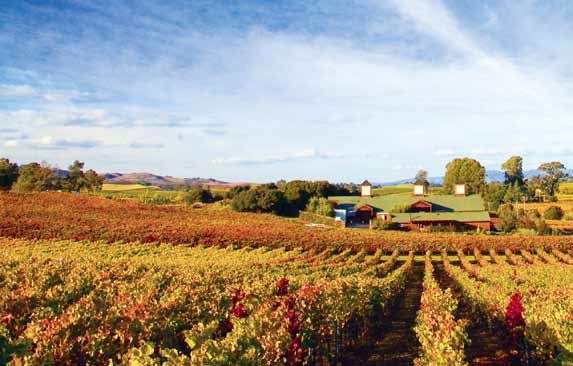 From a viticultural standpoint, farming has evolved as well at Bouchaine since Richmond arrived. Currently, 40 acres of Chardonnay, 40 acres of Pinot Noir, 4 acres of Pinot Meunier, and 2 acres of Pinot Gris and Pinot Blanc are estate grown. Both cane and cordon pruning are employed because of vintage variability. In some years, cane-pruned vines are more productive, in other years cordon-pruned vines are more productive, and in some years there is no difference. One of the most important changes in viticulture at Bouchaine has been the institution of deficit irrigation near harvest which prevents the grapes from being over stressed. Considering the seminal work of Richard Smart and others, it is now well known that grapes that are stressed at harvest can be under ripe and low in acidity (high pH), requiring sugar to be added. With irrigation, the grapes can be picked based on a choice of ripeness. There is no attempt to harvest fruit that is equally ripe. Michael believes, “Even ripeness is not what it is all cracked to be.” The 2007 vintage, for example, produced even ripeness but the wines did not turn out to be the winery's best and did not age well. In other vintages where uneven ripening occurred, the wines were better off with a mixture of less ripe and more ripe fruit. Generally, earlier picked grapes have more varietal aromatic and flavor typicality but can show green bean and rhubarb notes. Later picked grapes are fruitier but lack regional and varietal character. At Bouchaine, the goal is to hedge their bets by doing both types of picks, but veering more toward earlier picking to capture the aromatics. I tasted a vertical of Bouchaine Carneros Pinot Noir, 2008-2013. These wines usually contain about 60% estate fruit and 40% fruit sourced from four vineyards that the winery has worked with for many years including Gee Vineyards, Mahoney Vineyards and Casa Carneros, making these sourced grapes essentially estate as well. The vintage characteristics (Michael notes that fruit changes dramatically with different vintages and is a bigger factor than winemaking):
2008: Fire & ice; frost in late spring and then heat in August; Large clusters, uneven ripeness like Zinfandel
clusters, lean.
The smoky barrel regimen was evident in the 2008 and 2009 wines, but not aggressively so. The signature of Carneros Pinot Noir, according to Michael, is red cherry and tea berry flavors with a conifer-evergreen haze. Think of the part of a blueberry that is woodsy or evergreen. This signature was most evident in the 2010 vintage wine. The 2012 and 2013 vintage wines are a bit clunky and reticent at present which is expected from the house style.
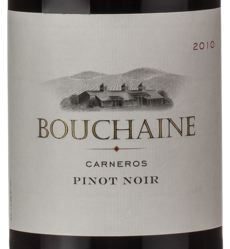
2008 Bouchaine Carneros Pinot Noir 14.1% alc., pH 3.48, TA 0.64, 8, 704 cases. Dijon, Pommard and Swan clones. Barrel aged in 33% new French, Hungarian and American oak. · Moderate reddish purple color in the glass. Enticing aromas of cherry, spice, conifer, mocha and smoky oak. Modest in weight but flavorful, with tastes of black cherry, blueberry, tar and tea. Still alive, fresh and fruity with some finishing interest. Very good.
2009 Bouchaine Carneros Pinot Noir 13.8% alc., pH 3.59, TA 0.59, 11,902 cases. Aged in 33% new French, American and Hungarian oak barrels. · Moderate reddish purple color in the glass. Nicely perfumed with bright cherry, spice, black tea, savory and smoky oak. Full-flavored and well-structured with plenty of tasty black raspberry fruit. Finishes with remarkable intensity and appeal. Very good + to Outstanding.
2010 Bouchaine Carneros Pinot Noir 13.8% alc., pH 3.50, TA 0.60, 9, 798 cases, $35. Current release. Small amount of Gee Vineyard fruit and Shop fruit from Walsh Vineyards Management. 33% new oak. · Moderate reddish purple color in the glass. Lovely nose of red cherry, teaberry, and savory oak. Plenty to like in this savory wine with compliments of black cherry, earth, mushroom and oak. Very good +
2011 Bouchaine Carneros Pinot Noir 13.6% alc., pH 3.58, TA 0.61, 3,655 cases. Unreleased. 33% new oak. · Moderate reddish purple hue in the glass. Very pretty nose featuring hi-tone cherry syrup and very modest oak input. Mid weight flavors of dark cherries and red currants with an earthy undertone. Nicely balanced tannins and a dry, charming finish. Very good.
2012 Bouchaine Carneros Pinot Noir 13.9% alc., pH 3.56, TA 0.55, 9,337 cases. Unreleased. 33% new oak. · Moderate reddish purple color in the glass. Shy fruit aromas with toasty oak and a bit of reduction which blows off over time in the glass. Mid weight flavors of purple berries including boysenberry. Very young and sense that the fruit is trying to come out. Slightly savory, with a herbal note. The tannins are nicely balanced and there is some finishing power. A well-crafted wine that needs more time in bottle. Very good +.
2013 Bouchaine Carneros Pinot Noir 14.2% alc., pH 3.60, TA 0.50, 6,158 cases. Unreleased. Estate plus a handful of lots from Gee Vineyard and Mahoney Vineyards. 33% new oak. · Moderate reddish purple color in the glass. Reticent aromas of darker fruits. Discreetly concentrated flavors of black cherry, boysenberry and pomegranate. Much better over time in the glass. Very young with slightly imposing tannins. Impressive mid palate attack and finish. A gorgeous wine with unlimited potential. Outstanding.
Pinot Meunier is infrequently bottled as a stand-alone clonal wine. It has attracted more interest in recent years, and both Mum and Domaine Chandon bottle versions of this varietal. The biggest challenge is to temper the wine which tends to be effusive, bold and tannic, and bring out its more delicate side. When Michael arrived at Bouchaine, there were two northeastern facing knolls on the property planted to failing Chardonnay. The Chardonnay was pulled out and Pinot Noir, clones 667 and 777, were planted on the steep terraces. The first three years provided disappointing wines, but more recently the wines have shined and shown enough individuality to be bottled separately as the “Terraces.” Mariafeld ("mu RYE a feld") clone has been used primarily as a blending component in Pinot Noir wines providing a foundation and color. Although it is a good producer and resists mold, it is not usually bottled separately as a stand alone clone because it lacks complexity and is dull in the mouth. The nose promises plenty of pleasure, but the palate doesn’t deliver. Michael has found, however, that some people prefer a straightforward “yummy” wine that they can drink without talking about the wine. He calls it a “teddy bear” wine that offers the consumer another option. The Sonoma Coast bottling is from a vineyard in the Petaluma Gap close to Carneros. It is a powerful wine with muscular tannins and cannot be added to the Carneros blend because it masks the Carneros signature. It is unique because nearby eucalyptus trees send micro droplets by wind that deposit on the grapes and lend a subtle “eucalyptoid accent” to the finished wine. A Gee Vineyard bottling is not produced every year. The mixture of old and new head-pruned vines in this 16- acre vineyard are not irrigated and tend to “tucker out” before reaching maturity, forcing an early pick, and can lack lack bottle worthiness. However, when the wine can be produced, it has a distinctive savoriness and hi-tone aromatics. The old vines are the “St. Clair clone” from the Carneros St. Clair Vineyard that is actually a Martini selection. The Gee Vineyard's newer plantings (mid 1990s) include Pommard, Swan selection and Dijon 115. The following Bacchus Collection wines from the 2012 vintage are sold through the tasting room and to wine club members.
2012 Bouchaine Carneros Estate Vineyard Pinot Meunier 13.5% alc., pH 3.53, TA 0.59, 879 cases, $40. Released May 2014. Aged in 40% new French oak barrels. · An array of purple and black fruits are featured on the nose which holds up nicely over time in the glass. Moderately rich and smoothly textured on the palate, this fruity wine is embellished with vivid deep purple and black berry, and black plum fruits robed in modest tannins. The fruit holds on to the generous finish. Very good +.
2012 Bouchaine Estate Vineyard Terraces Carneros Pinot Noir 13.8% alc., pH 3.60, TA 0.55, 599 cases, $60. Released November 2014. Dijon clones 667 and 777. Aged 11 months in 40% new French oak. · Shy aromas of black fruits and black tea leaves. Earthy with middleweight flavors of blueberry, pomegranate and blackberry. A distinct wine that builds in intensity over time in the glass. The finish is intense and long. Very good +.
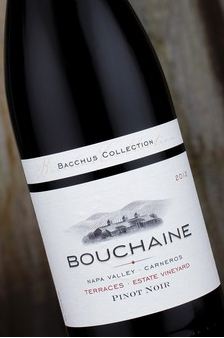
2012 Bouchaine Estate Vineyard Mariafeld Carneros Pinot Noir 14.5% alc., pH 3.53, TA 0.63, 266 cases, $40. Released May 2014. Aged 11 months in 33% new French oak. · Pleasant aromas of dark red cherry and berry with a touch of spice and floral bouquet. Smooth on the palate with a somewhat shallow attack. Juicy with a core of dark red fruits backed by muscular tannins. Lacks a bit of charm. Good.
2012 Bouchaine Rockin’ H Vineyard Sonoma Coast Pinot Noir 13.8% alc., ph 3.47, TA 0.58, 272 cases, $40. Released March 2014. 55% 777 and 45% 667. Aged 11 months in 40% new French oak. · Darkest in color. The nose features dark fruits with a hint of oak and eucalyptus. Intense and full-bodied array of dark berries saturating the mid palate and persisting on the softly textured and generous finish. Should benefit from more time in bottle. Very good.
2012 Bouchaine Gee Vineyard Carneros Pinot Noir 13.7% alc., pH 3.45, TA 0.60, 272 cases, $60. Released September 2014. Aged 11 months in 40% new French oak. · Savory aromas of dark cherries and berries. Smooth and polished on the palate with a discreetly concentrated array of dark red fruits. Nicely balanced and forward drinking, with some finishing intensity. Very good +
Although Pinot Noir has had a checkered past in Carneros, the quality of Chardonnay from this region has never been in dispute. In that regard, Bouchaine produces three superb Chardonnays that span the range of styles currently offered in California. Two extremes of winemaking technique are offered: Chêne d’Argent ($30), which is stainless steel fermented with no malolactic fermentation, and Bouche de Beurre ($50) which is a buttery, oaky version with full malolactic fermentation. The Estate Chardonnay ($30) is a blend of dozens of wines and includes the two extremes. The result is amazing complexity derived from the many different contributing wines including vines planted in 1981. The planted Chardonnay clones include Dijon, Rued, Robert Young, and 30-year-old UCD 5 & 6 “superclone.”
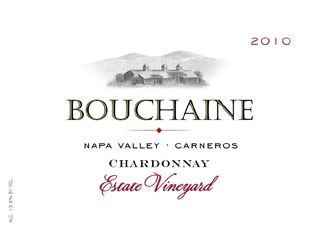 Bouchaine is one of the three wineries participating in the “Cube Project,” comparing wines from the same source made by three different winemakers. Visit www.princeofpinot.com/article/1195/ for more information. The Cube Project Pinot Noirs are available for purchase on the Bouchaine website at www.bouchaine.com. Bouchaine Vineyards produces 22,000 cases of wine per year. The tasting room is open daily from 10:30 AM to 4:30 PM from November to Mid-March. Tasting fees range from $20 to $30 per person. Self-guided walking tours of the vineyard are available weather permitting. Small group tours of the vineyards and winery are offered by appointment.
Sips of Recently Tasted California Pinot NoirQuality is consistently high for the 2012 vintage, with the wines often on the riper, more extracted side compared to the 2011 vintage. You might ask, “Why all the high scores.” The truth is, I review almost exclusively ultra premium Pinot Noir and the scores are well deserved.
Alma FriaAlma Fria (“al-mah-free-ah”) translates to the soul of a family or the cold of a geography). A new, very noteworthy player in the Pinot marketplace. Friendly people too. A member of West Sonoma County Vintners. Magnums available online too. Visit www.almafria.com.
2012 Alma Fria Sonoma Coast Pinot Noir 13.1% alc., 350 cases, $35. · Moderate reddish purple color in the galss. Nicely scented with hi-tone black cherries, black raspberries and a hint of oak. Strikingly silky on the palate with a luscious charge of black cherry, huckleberry and Marionberry flavors accented with spice and peppery herbs. Picks up intensity and interest over time in the glass, showing persistence on the berry-laden finish. Score: 91
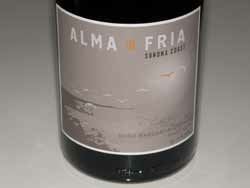 2012 Alma Fria Doña Margarita Vineyard Sonoma Coast Pinot Noir 230 cases, $58. 10% whole cluster. Native yeast fermentation. Aged in 25% new French oak. · Medium reddish purple color in the glass. Enchanting aromas of Damson plum, cherry and exotic spices which become more effusive over time. I have nothing but good things to say about this wine which features delicious dark red cherry, raspberry and plum flavors, soft tannins, lively acidity, good integration of oak, and impressive harmony. Exceptional length, cut and class. Score: 93
2012 Alma Fria Holtermann Vineyards Sonoma Coast Pinot Noir 12.9% alc., 185 cases, $58. · Moderate reddish purple color in the glass. Attention-getting aromas of cherry, sous-bois, bramble and complimentary oak spice. Nicely crafted, with flavors of plum, cherry, raspberry and spice and supportive soft tannins. Welcoming elegance, with a gorgeous note of fresh raspberry juice on the long finish. Even better later in the day from a previously opened and re-corked bottle. Score: 92
Bailiwick
2012 Bailiwick Borderline Marin County Pinot Noir 14.1% alc., 300 cases, $28. Sourced from Kendric and Chileno Valley vineyards. · Moderately light reddish purple color in the glass. Bright berry fruit aromas with hints of toast and herbs. Light to mid weight spice cherry and strawberry essence with a compliment of oak and a savory herb note in the background. Soft in the mouth, with supple tannins, a good cut of acidity, and very respectable finishing richness. An elegant, feminine wine that embraces the gentle side of Pinot Noir. Score: 90
2012 Bailiwick Sonoma Coast Pinot Noir 14.1% alc., 525 cases, $28. A blend of three vineyards along the cool Gravenstein Highway corridor. · Moderately light reddish purple color in the glass. The aromas of cherry and sous-bois are overwhelmed by oak-driven toast and coffee notes. The discreetly concentrated core of ripe cherries and raspberries is accented with a hint of red plum and spice. Less oak overlay is evident on the palate. The wine has balanced tannins and a finish that offers impressive fruit intensity. A comfortable, easy to drink wine. Score: 89
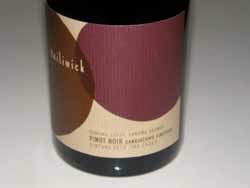 2012 Bailiwick Sangiacomo Vineyard Sonoma Coast Pinot Noir 14.5% alc., 100 cases, $38. Sourced from the Sangiacomo Vineyard on Roberts Road at the base of Sonoma Mountain in the Petaluma Gap region of the Sonoma Coast. · Moderately light ruby color in the glass. Highly fragrant nose with aromas of cherry, spice, dark chocolate and toasty oak. Fresh and vivid cherry fruit on the attack, very expansive in the mouth, embellished with generous oak, finishing with persistent spice-dusted cherry goodness. A very appealing wine that is ready for enjoyment now. Score: 92
Byron
 2012 Byron Monument Santa Maria Valley Pinot Noir 14.1% alc., pH 3.60, TA 0.53, 412 cases, $60. Composed of the winemaker’s selection of the finest barrels of the best blocks at the Nielson Estate. Swan, 667 and Pommard clones. Aged 16 months in 70% new French oak barrels. · Moderately dark reddish purple color in the glass. The aromas are hitone right out of the opened bottle, featuring blackberry, black currant, and plenty of spicy, sweet oak. Full-bodied, with well-ripened flavors of blackberry, cassis and cola. The wine has heft but is tempered by a juicy brightness that appeals. Balance is spot on and there is noticeable length to the fruit-infused finish. The svelte tannins provide good support and promise of age ability. Score: 91
2012 Byron Julia’s Vineyard Santa Maria Valley Pinot Noir 13.9% alc., pH 3.63, TA 0.53, 344 cases, $45. Sourced from a small block of old vines planted in 1974. Aged 16 months in 50% new French oak barrels. · Moderately dark reddish purple color in the glass. A nose of nuance with scents of red and black berries, baker’s spice, raw beef, and toasty oak. Full-bodied, oak-infused flavors of cherries and strawberries. This wine has a bold demeanor, but is not muscular. The tannins are well integrated and the wine is easy to like, although oak tends to play a prominent role in its demeanor. Score: 89
Dutton-Goldfield
2012 Dutton-Goldfield Dutton Ranch Fox Den Vineyard Green Valley of Russian River Valley Pinot Noir 13.5% alc., pH 3.61, TA 0.60, 654 cases, $58. Vineyard is located at the far western edge of the Green Valley AVA. 8 acres planted in low vigor Goldridge sandy loam soils. Planted in 2002 to clones 667, 777 and 115. 100% de-stemmed, 5-day cold soak, open top fermentation, punch downs. Aged 15 months in 50% new French oak barrels. · Moderately dark reddish purple color in the glass. Highly aromatic, with notes of black cherry, black raspberry, sage and toffee. Middleweight flavors of black raspberry, blackberry and ripe strawberry are arrayed on a plush, comforting texture. Very juicy and thirst quenching with an uplifting finish. This wine sports the most oak overlay of the four wines reviewed here. Score: 90
2012 Dutton-Goldfield Dutton Ranch Freestone Hill Vineyard Russian River Valley Pinot Noir 13.5% alc., pH 3.65, TA 0.61, 613 cases, $72. This vineyard is located above the town of Freestone on the far southwestern edge of the Russian River Valley only a few miles inland from Bodega Bay. This very cold site is suited to Dijon clones. Planted in 1996 and 1997 to 115, 667, 114 and Wädenswil 2A. · Moderately dark reddish purple color in the glass. Enchanting aromas of raspberry coulis, black cherry pie glaze, spice and toasty oak. Delicious on entry with expansive fullness and polish, offering intense flavors of darker berries and Asian spices. The tannic backbone insures age ability while the lengthy finish leaves a memorable impression. Score: 92
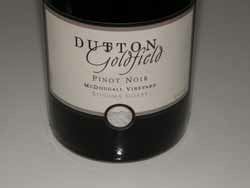 2012 Dutton-Goldfield McDougall Vineyard Sonoma Coast Pinot Noir 14.1% alc., pH 3.65, TA 0.60, 390 cases, $58. The vineyard is on a south-facing ridge close to coast farmed by Mac, Barbara and Rich McDougall. 2 Dijon clones were planted on 9 acres in 1998 upon the urging of Warren Dutton. 1,100 feet elevation. Neighbors are Hirsch and Martinelli vineyards. Grapes are typically thick skinned with deep color and natural spice. 100% de-stemmed, 7-day cold soak, open-top fermentation with punch downs. Aged 14 months in 50% new French oak barrels. · Moderately dark reddish purple color in the glass. Shy, but pleasant aromas of wild dark raspberries and blueberries, and brambly underbrush. The fruit really grabs your attention on the mid palate, filling every nook and cranny in the mouth, and holds on through an intensely fruity finish. There is plenty of blueberry and blackberry flavor accented with many nuances including cardamom spice, subtle oak, earthy flora, and ironbased minerality. A special wine of uncommon complexity that can go the distance. Score: 94
2012 Dutton-Goldfield Devil’s Gulch Vineyard Marin County Pinot Noir 13.5% alc., pH 3.60, TA 0.61, 431 cases, $68. A steep, terraced vineyard farmed by owner Mark Pasternak. Record crop, yields 1.5 tons per acre. Very tiny berries.100% de-stemmed, 5-day cold soak. Aged 17 months in 45% new French oak barrels. · Dark reddish purple hue in the glass. Lovely aromas of fresh Bing cherry and black raspberry with a dusting of cocoa and vanilla powder. My notes say, “WOW!” upon entry, with a deep, vibrant, well-spiced plum and black raspberry core that makes you sit up in your chair. The supportive tannins are very fine-grained, and their is enough oak undertow to add interest. The wine is impeccably balanced with a remarkably long finish that seems to last over a minute. Score: 93
Furthermore
2011 Furthermore Rosella’s Vineyard Santa Lucia Highlands Pinot Noir 14.3% alc., 81 cases, $50. · Moderate reddish purple color in the glass. Aromas of strawberry, cherry and nutmeg draw you into the glass. Beautifully composed and harmonious with gentle tannins balancing the flavorful dark red cherry and berry fruits. There is a touch of dark chocolate, sarsaparilla, vanilla and char adding interest. The attack is expansive and the finish has impressive length. Rosella’s always is a more feminine wine than many from the Santa Lucia Highlands and that character is exemplified in this wine. Score: 92
2011 Furthermore Weir Vineyard Yorkville Highlands Pinot Noir 14.0% alc., 65 cases, $50. A blend of Wädenswil clone and a Romanee-Conti selection. · Moderately light reddish purple color in the glass. A heavy tug of oak dominates the nose which offers demure aromas of black cherry and dark berry jam. More interesting on the palate with less undertow of oak, offering flavors of boysenberry and purple grapes. Rather closed and reticent, and even a bit shallow, tasting primarily of unadorned grape juice. Worth revisiting in a year or so. Score: 88
2011 Furthermore La Encantada Vineyard Sta. Rita Hills Pinot Noir 13.6% alc., 85 cases, $40. · Moderately dark reddish purple color in the glass. This wine speaks of Sta. Rita Hills with good dark fruit intensity and bright acidity. The aromas of blackberry, black currant and licorice are enticing, and mid weight flavors of blackberry, black plum, eucalyptus and spice satisfy. A bit of toast and mocha are in the background. The fruit has good verve, and the mouthfeel is velvety. Score: 90
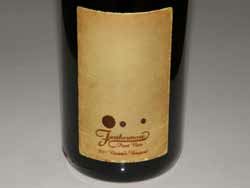 2011 Furthermore Nevina’s Vineyard Sonoma Coast Pinot Noir 13.8% alc., 83 cases, $50. Furthermore’s first estate vineyard. Located in Occidental six miles from the coast planted in 2002 to clone 777 by Scott Zeller. The vineyard was formerly known as Willow Creek and was bottled as a vineyard designate by Rivers-Marie. · My first experience with this vineyard and WOW! Moderately dark reddish purple hue in the glass. Intoxicating aromas of freshly picked and crushed wild berries, spice, and ocean breeze. A little bit untamed, rugged and spirited, with delicious flavors of boysenberry, blackberry, molasses and dark chocolate and a firm tannic spine. The fruit has character and speaks of the earth and a sense of place. The experience is like throwing down fresh, juice berries while sitting on a ridge top overlooking the Pacific Ocean on the Sonoma Coast. This is one sexy wine that really stands out among the excellent Furthermore Pinot Noirs in 2011. Score: 94
Laetitia
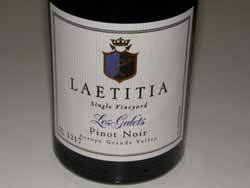 2012 Laetitia Single Vineyard Les Galets Arroyo Grande Valley Pinot Noir 14.1% alc., $60. Low yielding blocks. Dijon 115 and Wädenswil 2A clones. · Moderately dark reddish purple hue in the glass. Deep aromas of blackberry, boysenberry, anise and vanilla. Full-bodied flavors of dark berries, plum reduction sauce, and Asian 5-spice. The flavor is amazing! The luscious fruit load is beautifully balanced by melded tannins and balanced acidity. Caressing and creamy in the mouth, with a hint of oak enlarging the envelope, the wine finishes replete with soaring fruit fragrances. I’m in love. Score: 94
2012 Laetitia Single Vineyard La Colline Arroyo Grande Valley Pinot Noir 13.9% alc., $60. Low yielding blocks in the estate vineyard. Martini 13 clone. · Moderate reddish purple color in the glass. The aromas and flavors of black cherry, spice, rose petal and toasty oak are satisfying, with good tension and length. The lovely cherry fruit is complimented by well-managed oak and bright acidity. A little lighter in weight, with slightly less ripened and redder fruit than the Les Galets, but still very charming. Score: 92
Soliste
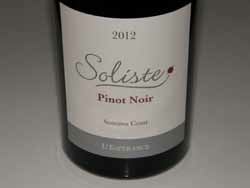 2012 Soliste L’Espérance Sonoma Coast Pinot Noir 13.1% alc., 241 cases, $85. Monoclone - 115. · Moderate reddish purple color in the glass. Intense aromas of black cherry, black raspberry, loamy soil, baking spice and iron, building in expression with time in the glass. Silky soft and feminine in character, with layers of black cherry and black raspberry fruits touched by an array of savory herbs and a floral accent. The wine fills the mouth with pleasure that carries over to the long and expansive finish. The wine has a racy energy that primes the palate for more. Even better the following day from a previously opened and recorked bottle with aromatics that leap from the glass. Score: 92-93
Stomping Girl
2012 Stomping Girl Lauterbach Hill Russian River Valley Pinot Noir 14.2% alc., $38. This vineyard is owned by boutique grower and producer Stew Lauterbach, and is located just off River and Olivet Roads behind Martinelli Winery. Lee Martinelli, Jr., farms the vineyard. Pommard and Dijon clones. 3 to 5-day cold soak, 10-day fermentation, basket pressed with only finest press wine kept. Aged in French oak barrels which are mostly neutral. Racked once, then bottled unfined and unfiltered. · Moderately light garnet color in the glass. This beauty smells like cherry pie class at cooking school with added scents of raspberry and dried herbs. The light to mid weight array of vibrant red fruits are embellished with a subtle savory herb flavor in the background. Crisp, with well integrated tannins and a juicy, cherry-infused finish. Score: 90
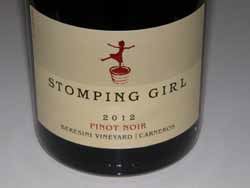 2012 Stomping Girl Beresini Vineyard Carneros Pinot Noir 14.2% alc., $36. Vineyard planted by Steve Beresini in 1989 using cuttings from his friend Larry Hyde. Calera, Pommard and 777 clones. Aged in French oak barrels which are mostly neutral. Racked once, then bottled unfined and unfiltered. · Moderate reddish purple color in the glass. Interesting aromas of black cherry, mulch, truffle and toasty oak lead to mid weight palate of earthy and spiced black cherry, tea berry and black raspberry fruit flavors. Plenty of sap and intensity to satisfy, yet welcoming and polished. The finish is impressively long and satisfying. This wine bears the signature of Carneros. Score: 92
TR Elliot
2012 TR Elliott Queste Russian River Valley Pinot Noir 14.5% alc., 410 cases, $44. Released May 2014. 8 barrels of Hallberg Vineyard clone 115 and 9 barrels of O’Connell Vineyard Pommard clone. Goldridge sandy loam soils. 20% whole cluster, native yeast fermentation. Aged 11 months in 34% new French oak barrels. · Moderate reddish purple hue in the glass. Fresh aromas of strawberry, cherry, rose petal and spicy oak. Very nicely composed, with appealing flavors of Bing cherry syrup, cola and baking spices. A cherry-driven wine with balanced tannins and deft oak compliment. Highly enjoyable now, but has the balance for long term enjoyment. Score: 91
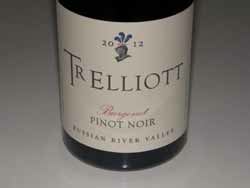 2012 TR Elliott Burgonet Russian River Valley Pinot Noir 14.5% alc., 200 cases, $46. Released October 2014. 8 barrels of 2-acre O’Connell Vineyard. Goldridge sandy loam soils. 100% Pommard clone. 20% whole cluster. Native yeast fermentation. Aged 11 months in 20% new and 38% once-used French oak barrels. Unfiltered. · Moderate reddish purple color in the glass. Enchanting nose with an array of scents including black cherry, black raspberry, sweet spice and potpourri. Well-endowed with flavorful and vivid fruits including dark red cherries, blueberries and pomegranate. The mid palate attack is attention grabbing and the finish is generous. This wine aims to please now, but will drink nicely for several years. Score: 91
More
2013 Belle Glos Clark & Telephone Santa Maria Valley Pinot Noir 14.7% alc., 4,757 cases, $40. Martini clone own rooted since 1972. Aged 9 months in French oak. · Dark violet color in the glass. The nose is infused with oak vanillin as is typical of Belle Glos wines. Added aromas of dark berries and purple rose elevate the nose. Big and bold, with plenty of sappy boysenberry and black raspberry fruit flavors, accented with espresso, spice and vanilla. Despite its heft, the wine is not ponderous, and the tannins are well matched. A very stylistic wine that might not appeal to the Pinot Noir purist, but well done in its style. Score: 89
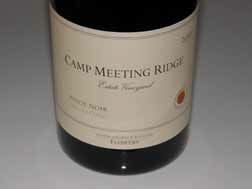 2012 Flowers Vineyard & Winery Camp Meeting Ridge Estate Vineyard Sonoma Coast Pinot Noir 12.9% alc., pH 3.91, TA 0.65. $85. Organic and biodynamically farmed vineyard at elevations of 1,150 to 1,400 feet with schist and shale soils. Swan, Pommard, 114, 115 and Wädenswil 2A. 20% whole cluster.. Yields 2.4 tons per acre. 20% whole cluster. Aged 16 months in 20% new French oak. Unfined and unfiltered. · Moderately light reddish purple color in the glass. Intriguing aromas of dark cherry sauce, sous-bois, and wood spice. Modest in weight with a core of spicy red fruits include red grape. Polished with fine grain tannins and a welcome accent of toasty oak. The finish impresses with persistent fruit fragrance and bright acidity. This wine seduces rather than attacks with power. Score: 92
2012 Garnet Vineyards Monterey County Pinot Noir 14.2% alc., $20, screwcap. · Moderately light reddish purple color in the glass. Smoky oak overrides the fruit in this light to mid weight wine featuring cherry and black raspberry flavors. Smooth, even slightly creamy, and easy to drink, but oak plays too big a role for me to thoroughly enjoy the wine. Score: 86
2011 Hartley Ostini Hitching Post Highliner Santa Barbara County Pinot Noir 13.5% alc., $34. A highliner is the best fisher in the fleet. This wine honors the men of SE Alaska salmon fishery alongside whom Gray Hartley fished for 28 years. A barrel selection from two Santa Barbara vineyards. · Moderate reddish purple color in the glass. The aromas of blackberry, black raspberry and spice fill the glass. Modestly weighted flavors of spicy black cherry and blackberry, with a hint of toast and anise in the background. The wine has soft, ripe tannins, good brightness, and commendable harmony. Score: 89
2010 Kistler Sonoma Coast Pinot Noir 14.1% alc., $N/A. · Moderately dark reddish purple color in the glass. The nose features aromas of blackberry jam, black currant and black plum with a toasty, smoky oak overlay. Plenty of weight and sappy presence of purple and black berries on the palate backed by firm, dry tannins. An undertow of oak shows up on the finish that offers some intensity and length. More swagger than finesse. Score: 87
 2013 Press Cellars Helluva Vineyard Anderson Valley Pinot Noir 14.0% alc., $40. New release. From a 5.5-acre vineyard managed by Sal Galvan who is also the winemaker along with proprietor Patrick Campbell. Inaugural Pinot Noir release from this winery. 100% destemmed. Aged 10 months in 60% new French oak barrels. · Moderate reddish purple color in the glass. Aromas of black cherries, bacon fat and nutty oak. Mid weight plus flavors of black cherry, black raspberries, brown spice and a touch of smoke, anise-laced oak. Nicely balanced with modest tannin and acidity. The mid palate attack is robust and the finish is filled with darker fruit goodness. Better the following day from a previously opened and re-corked bottle with better oak integration and more soaring aromatics. A solid wine that will find appeal. Score: 90
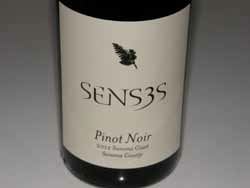 2012 SENS3S Sonoma Coast Pinot Noir 13.4% alc., pH 3.78, TA 0.54, $40. Sourced from Hillcrest Estate and Tanuda vineyards. Barrel aged 11 months in 25% new French oak. · Noticeably better than when previously tasted in July 2014. Moderate reddish purple color in the glass. Attractive aromas of black cherry, rose petal, spice and mulch. Very tasty core of fresh black cherry, blueberry and pomegranate fruits with some length and intensity on the finish which sports a good cut of acidity. There is better integration of tannins and oak since last tasted. Score: 90
2012 St. Rose Nunes Vineyard Ten Block Russian River Valley Pinot Noir 13.4% alc., pH 3.60, TA 0.67, 98 cases, $38. Sampled from all ten blocks of the vineyard. 35% 115, 40% 777, 10% 667, 15% 114. Aged 12 months in 1 and 2-year-old Francois Frères oak barrels. Unfined and unfiltered. · Moderate reddish purple color in the glass. Aromas of oak-infused cherry syrup, peppery spice and forest floor. Appealing mid weight core of spicy Bing cherry with an oak overlay and modest tannins. Some finishing power with a tart cherry theme. Tasted twice. Score: 87-88
Sips of Recently Tasted Oregon Pinot NoirThe 2012 vintage in the Willamette Valley produced wines that generally are riper, more extracted, with more tannin and higher in alcohol than the past two cool vintages. Some writers have been critical, claiming the wines are more fruit-driven and California in style. I say, hey, that is what the vintage gave, and celebrate the glorious, opulent fruit flavors. Many of the wines will benefit from a year or two more in bottle.
Big Table Farm
2012 Big Table Farm Sunnyside Vineyard Willamette Valley Pinot Noir 14.1% alc., 230 cases, $48. The owners of this vineyard have tended it for over 30 years. · Moderate reddish purple hue in the glass. Appealing initially, with bright aromas of berry jam, spice and subtle smoky oak, picking up appeal over time in the glass. A mid weight, glorious combination of plum and boysenberry fruits with a riff of smoke and anise. The fruit is ripe but not over ripe and definitely makes a statement. The texture is silky, the tannins are reserved, and the finish offers a good cut of citrus-driven acidity. This wine could use a little more time in bottle for the smoky oak to fully integrate. Score: 91-92
2012 Big Table Farm Cattrall Brothers Vineyard Willamette Valley Pinot Noir 13.2% alc., 161 cases, $49. Tom and Bill Cattrall organically farm this vineyard in the Eola-Amity Hills. Own-rooted Wädenswil vines. Fermented 50% whole cluster. · Moderately dark reddish purple color in the glass. The nose offers aromas of black cherry, Marionberry, briar patch and tobacco oak. Modest in concentration but highly flavorful, with a good tannic backbone and acid spine. The middleweight flavors of plum reduction sauce and berry preserves are somewhat sappy and accented with a tug of oak. The lip smacking good finish is riff with bright acidity. Score: 89-90
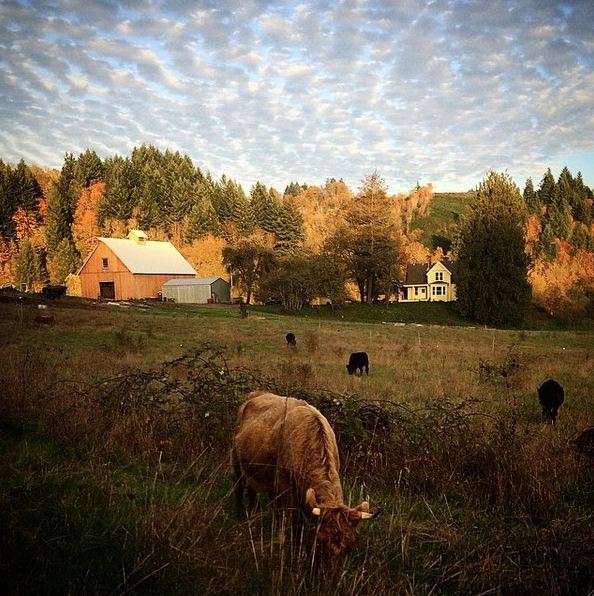
2012 Big Table Farm Wirtz Vineyard Willamette Valley Pinot Noir 14.3% alc., 232 cases, $48. · Moderate reddish purple hue in the glass. Highly aromatic, with bright scents of fresh raspberry coulis, cherry sauce, spice and a bit of smoky oak. A lovely wine with character, displaying a discreetly concentrated core of black cherry and black raspberry fruit. Definitely ripe but not over ripe, with a complimentary accent of oak-driven anise and black tea. The finish is persistent and highly pleasing, driven by tart cherry acidity. Tasted the 16 following day from a previously opened and re-corked bottle, more floral and spice accents appear, and the soft, fine tannins make for a dreamy mouthfeel. Score: 92
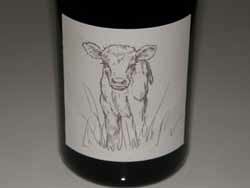 2012 Big Table Farm Resonance Vineyard Yamhill-Carlton Willamette Valley Pinot Noir 14.7% alc., 326 cases, $48. Last vintage from this vineyard which was sold to Burgundy producer Louis Jadot in 2013. · Moderately dark reddish purple color in the glass. The nose is stunning, with an array of nuanced scents including plum, blackberry, black raspberry, sous-bois, exotic spices and bark. Mid weight plus core of well-ripened purple and black fruits, nicely spiced with well-integrated oak. Very fruity, slightly sweet and juicy, with a firm tannic backbone. Bigger, riper and sappier in this vintage as one would expect from a site in a warmer vintage. Evolves beautifully over time in the glass and is much better later in the day, offering a remarkably long grand cru finish. A memorable swan song. Score: 94
Broadley Vineyards
2011 Broadley Vineyards Claudia’s Choice Willamette Valley Pinot Noir 13.7% alc., $50. Sourced from 7 acres of northeast-facing vines planted mid slope on the estate. · Light reddish purple color in the glass. Fruity aromas of red cherry, raspberry and strawberry. Light in weight with juicy cherry flavor dominated by smoky, tobacco oak. The oak simply overwhelms the delicate red fruit core. There is also a green, vegetal thread in the background. Very mild tannins and easy drink ability. Score: 86
2012 Broadley Vineyards Claudia’s Choice Willamette Valley Pinot Noir 13.7% alc., 350 cases, $50. Named after Broadley’s cofounder Claudia Broadley. From a section of the vineyard that ripens later and sets smaller clusters. Pommard and Wädenswil clones. 40% whole cluster. Wild yeast fermentation. Aged 14-18 months in 40% new French oak barrels. The wine is meant to display a big, complex character. · Moderately dark reddish purple color in the glass. Shy aromas of plum and boysenberry lead to a full-bodied explosion of luscious purple and black fruit flavors spiced with Coca-Cola, and backed by husky tannins. A prodigious wine with serious extract and finishing power. Similar the following day from a previously opened and re-corked bottle with high extraction and healthy tannins. A distinctive style of wine that will benefit from some aging. Score: 88-89
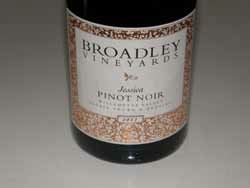 2012 Broadley Vineyards Jessica Willamette Valley Pinot Noir 13.7% alc., 250 cases, $50. Named after Jessica Broadley, Morgan Broadley’s spouse and partner in Broadley Vineyards. Clones 667 and 115. 80% whole cluster. Wild yeast fermentation. Aged 14-18 months in 50% new French oak barrels. · Moderately dark reddish purple color in the glass. Plentiful fruit in this wine that offers scents of black cherry reduction sauce and blackberry jam, and intense, sappy flavors of purple and black fruits. There is a complimentary hint of spice and oak and a slight floral undertone from the whole cluster inclusion. The tannins are substantial but proportional to the fruit load creating balance. This wine is not for the timid, but it is nicely composed and will thoroughly satisfy those seeking out a full-throttle Pinot Noir with whole cluster embellishments. Score: 90-91
Croft Vineyards
2011 Croft Vineyards Savoir-Vivre! Willamette Valley Pinot Noir 13.5% alc., $35. Made from organically grown grapes. Croft Vineyards has grown grapes organically for over 30 years. This wine is made from grapes from some of the oldest vines. Produced and bottled by 720 Wine Cellars in Philomath. · Moderate reddish purple hue in the glass. Aromas of raspberry, Damson plum, peppery spices, stem and oak. Light to mid weight flavors of red cherry, red raspberry and red plum with a savory herbal thread in the background. Soft on the palate with mild fine-grained tannins, and a slightly tart, cherry-driven finish. Pleasant but not exceptional. Score: 88
de Lancellotti Family Vineyards
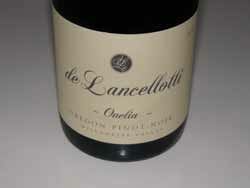 2012 de Lancellotti Onelia Willamette Valley Pinot Noir 14.4% alc., $45. · Moderate reddish purple color in the glass. Very shy aromas of berries on the vine with a woodsy undertone. Delicious and super intense core of cherry and raspberry fruits, finishing with power and length. The fruit is complimented by a touch of oak vanillin. Slightly grippy tannins show up on the big finish. Plenty of Pinot singing in this wine. Needs bottle aging for the aromas to arrive. Score: 92
Domaine Drouhin Oregon
2011 Domaine Drouhin Oregon Édition Limitée Dundee Hills Willamette Valley Pinot Noir 13.9% alc., 245 cases, $85. Estate grown. Mostly from a single block planted in 1998, with a little of a neighboring block planted in 1999. · Moderately dark reddish purple color in the glass. Shy aromas of oak-kissed black cherry, sandalwood and baking spice. Very tight and not particularly gregarious, with a medium bodied core of black cherry, cranberry and raspberry fruits buried in oak and brutish tannins. A little more fruit and spice peeks out and the tannins are slightly softer the following day from a previously opened and re-corked bottle. Three days later, the opened wine is beginning to shine. This wine is built for the long-haul, and will not appeal if drunk now unless vigorously decanted. Score: 90-91
Durant Vineyards at Red RidgeThe Durants of Dayton, Oregon, are among the state’s pioneering winegrowers, having planted their first vines in the Willamette Valley in 1973. Today, Durant Vineyards encompasses 60 acres, and is a prime source of fruit for 14 wineries, such as Patricia Green Cellars, Lange Estate Winery, Joe Dobbes Wines, Owen Roe, Big Table Farm and Matello. The family also produces 3,000 cases per year of estate wine, crafted by six winemakers who are selected to feature each of the estate vineyard’s seven blocks. The innovator behind the operation is fourth-generation farmer, Paul Durant. In 2012, he cofounded the Oregon Chardonnay Symposium, oversees Durant Vineyards, and is the Master Miller for the family’s Oregon Olive Mill, the only estate olioteca in the Pacific Northwest. Both companies fall under the umbrella of Red Ridge Farms, a destination that includes a gourmet retail store, nursery, and on site accommodations. Visit www.redridgefarms.com.
2012 Durant Vineyards Bishop Dundee Hills Willamette Valley Pinot Noir 14.2% alc., pH 3.67, 204 cases, $65. Bishop is one of the original 1973 blocks planted to Pommard clone with some own-rooted vines. The wine is vinified by winemaker Isabelle Dutarte. Harvest Brix 24.2º. Yields 0.75 tons per acre. · Moderately dark reddish purple color in the glass. Brooding aromas of oak-dusted black fruits. Lovely purple stone and berry mid weight sappy fruits with a lush mid palate attack and a vivid and rich fruit-laden finish. A big wine for Oregon but the fruit is buffered by firm ripe tannins and is not daunting. Similar the following day from a previously opened and re-corked bottle. Give this wine some time for the aromas to arrive and the rich fruit to temper. Score: 91
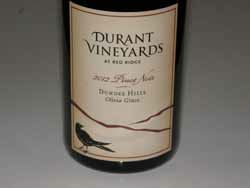 2012 Durant Vineyards Olivia Grace Dundee Hills Willamette Valley Pinot Noir 13.0% alc., pH 3.61, 165 cases, $60. This block was planted in 2006 to Pommard clone and is named after one of Paul Durant’s two daughters. The wine was vinified by winemaker Chad Stock of Minimus Wines. 100% Pommard clone. Harvest Brix 22.5º, yield 1.5 tons per acre. · Although also made from Pommard clone, this wine is distinctly different from Bishop. The nose is extravagantly scented with aromas of cherry, rose petal, and spice. The fruit load is luscious and intense, but the tannins are more reserved, and this wine displays plenty of vibrancy and up front enjoyment. Two days later, when tasted from a previously opened and re-corked bottle, this wine had taken on added interest with seductive aromas of cherries and spice and a delicious array of red fruit flavors that spoke Pinot in character. Score: 92
Evesham Wood
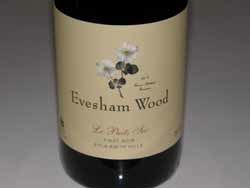 2012 Evesham Wood Le Puits Sec Eola-Amity Hills Willamette Valley Pinot Noir 13.0% alc., $33. Made from organic grapes sustainably grown and non-irrigated. Unfiltered. · Moderate reddish purple color in the glass. Enchanting aromas of black cherry sauce, exotic spices, and Herbs de Provence. A captivating, very sexy nose. Soft and charming on the palate with a discretely concentrated core of spicecharged dark plum and black raspberry fruits. Beautifully balanced with enough tannic backbone to age, and a crazy long finish that really satisfies. This is a wine that stands out from the crowd. Score: 93
Le Cadeau Vineyard
2012 Le Cadeau Vineyard Merci Reserve Chehalem Mountains Willamette Valley Pinot Noir 14.4% alc., 95 cases, $80. Release December 2014. The finest barrels from the vintage crafted in tiny quantity. Three heritage selections. Winemaker is Jim Sanders and growers and owners are Deb and Tom Mortimer. · Moderately dark reddish purple color in the glass. Exotic aromas elevate the nose including black cherry, Asian 5-spice, incense and smoke. Full-bodied core of delicious spiced black cherry and blackberry flavors that are intense and persistent. There is plenty of smoky oak on board ala Henri Jayer. The mouthfeel is polished and the finish is a joyous celebration of fruit and lip smacking acidity. A very unique wine, but the oak plays too great a role for me personally. Score: 90
Matello Wines
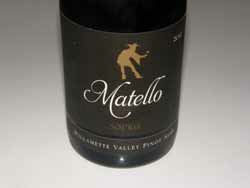 2012 Matello Souris Willamette Valley Pinot Noir 13.2% alc., 275 cases, $42. · A tête de cuvée. Crafted from old, non-irrigated vines. Moderately light reddish purple color in the glass. Lovely aromas of cherry tart, sandalwood and underbrush. Bright and juicy with light to mid weight flavors of cherry, raspberry and cranberry. Delicate and elegant, yet highly flavorful. Firm tannins buttress the fruit and bright acidity adds tension. The wine finishes with a pleasing grip of cherry fruit. Still appealing the following day from a previously opened and recorked bottle reflecting balance and predicting age ability. Score: 91
ROCO
2012 ROCO Wit’s End Chehalem Mountains Willamette Valley Pinot Noir 14.0% alc., 250 cases, $42, screwcap. An estate vineyard planted to Dijon clones in sedimentary soil. Winemaker Rollin Soles. · Moderately light reddish purple hue in the glass. Nicely perfumed with hi-tone scents of fresh cherries, sousbois, spice and dried rose petals. The core of bright cherry fruit is flavorful and vivid, and complimented by a deft touch of oak. The tannins are well integrated and the highly pleasurable finish is long and full of Pinot goodness. Score: 91
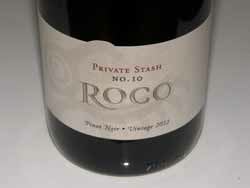 2012 ROCO Private Stash No. 10 Wit’s End Vineyard Chehalem Mountains Willamette Valley Pinot Noir 14.0% alc., 320 cases, $66, screwcap. · This wine is not as developed as the Wit’s End bottling but has more potential long term. Moderately light reddish purple color in the glass. Very pretty aromas of dark red cherry, raspberry and spice box. Soft, smooth and silky on the palate with delicious flavors of juicy black cherry and a hint of red licorice. Very seductive, with supple tannins, a welcome hint of oak, and a good spark of refreshing acidity on the lasting finish. Tasted the following day from a previously opened and re-corked bottle, the wine was holding its own, predicting its long term potential. Score: 92-93
Shea Wine Cellars
2012 Shea Wine Cellars Shea Vineyard Block 7 Willamette Valley Pinot Noir 14.7% alc., $59. Wädenswil clone from the 5.2-acre non-irrigated Block 7, located on a steep, south-facing slope. · Moderately light reddish purple color in the glass. The nose picks up interest and intensity over time, offering aromas of black cherry, pomegranate, rose petal, mocha and sandalwood. An earthy undertone compliments the fat, plummy, black cherry and spice flavors which are accented with oak. Silky in texture, with firm tannins and juicy acidity. The wine is shy and lacks distinction at this stage. When tasted the following day from a previously opened and recorked bottle, the fruit was more expressive. I would check back in another year. Score: 88-89
2012 Shea Wine Cellars Shea Vineyard West Hill Willamette Valley Pinot Noir 14.6% alc., $59. Wädenswil, 777, 114 and Pommard clones. · Moderately light reddish purple color in the glass. Aromas of black cherry, black raspberry, cherry leather and bramble lead to a middleweight, juicy wine featuring dark red and purple fruits. Fruity, with firm tannins and a noticeably silky mouth feel. Nicely balanced, but seems linear and very reserved. Re-tasted the following day from a previously opened and re-corked bottle, the wine was about the same. Score: 89-90
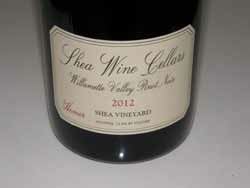 2012 Shea Wine Cellars Shea Vineyard Homer Willamette Valley Pinot Noir 14.6% alc., $79. A blend of the best barrels in the cellar. Dijon and Wädenswil clones. Aged in 68% new French oak. · Moderate reddish purple color in the glass. The nose is very shy and tight, opening slowly to reveal aromas of black cherry, blackberry and wooded forest. More body, more life and more finish in this wine. The array of dark stone and berry fruits sparkle, accented with interesting notes of spice and anise. A big, masculine wine with plenty of oak overlay and tannic vigor at this time. Slightly more charming the following day from a previously opened and re-corked bottle. Keep this one in the cellar for a couple of years. Score: 90-91
Soter Vineyards
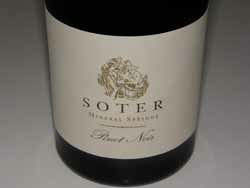 2011 Soter Mineral Springs Estate Grown Yamhill-Carlton Willamette Valley Pinot Noir 13.6% alc., 540 cases, $85. A selection created only in a given vintage when something unique begs the spotlight. This is the fourth bottling of Mineral Springs Pinot Noir and is sourced primarily from Heirloom clones. 30% whole cluster fermentation. 30 days extended maceration. Aged 12 months in 50% new French oak barrels. Racked once for assembly before bottling. · Moderately dark reddish purple color in the glass. Very pleasant nose with aromas of black raspberry and spice picking up intensity over time in the glass. Richly fruited with blackberry, plummy, and black currant flavors, with a touch of blueberry-pomegranate chiming in. Substantial, but not excessive tannins and a citrus-driven, bright finish. A high-collared wine of elegance and charm. Still highly aromatic and flavorful the following day from a previously opened and re-corked bottle. This beauty will easily age another ten years. Score: 93
Westrey
2012 Westrey Justice Vineyard Eola-Amity Hills Willamette Valley Pinot Noir 13.5% alc., $33. Winemakers Amy Wesselman and David Autrey. Unfiltered. · Moderate reddish purple color in the glass. A little more oak than fruit on the nose now and a bit tight, offering aromas of black cherry, fennel, pine and smoky oak. A well-crafted, beautiful wine but the fruit flavors of dark cherry, blackberry and plum have not fully emerged. Well-structured and mid to full-bodied with a big fruit-driven finish. Soft and plush, but not overly fat on the palate. Give this wine at least another year in bottle for full enjoyment. Score: 90
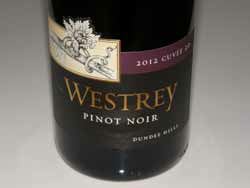 2012 Westrey Cuvée 20 Dundee Hills Willamette Valley Pinot Noir 13.5% alc., $49. 20th vintage. Sourced from 35-year-old dry-farmed vines. 25% “Coury clone” Abbey Ridge Vineyard and 75% Pommard clone Oracle Estate Vineyard. Unfiltered. · Moderate reddish purple color in the glass. Somewhat reticent, offering demure aromas of dark red berries, cherries and sous-bois. Delicious flavors of dark red fruits with the slightest oak adding a welcome accent. Fresh and juicy with good tension, balanced tannins, an intense mid palate attack, and a generous finish displaying a good cut of acidity. Tasted the following day from a previously opened and re-corked bottle, the wine was more savory and slightly gamey with a remarkably long finish. This wine should age effortlessly. Score: 91-92
Tyee Wine Cellars
2012 Tyee Wine Cellars Estate Willamette Valley Pinot Noir 13.5% alc., 400 cases, $28. Released September 2014. From grapes grown exclusively in the family vineyard adjacent the winery. A combination of all plantings in the Estate Vineyard from vines 12 to 38 years old. 99 points and #1 wine Portland Monthly Oregon’s 50 Best Wines 2014. Merrilee Buchanan Benson is the winemaker. · Moderately light reddish purple color in the glass. Aromas of sous-bois, cherry, cranberry, raisin and a hint of oak. Light to mid weight flavors of dark cherries and purple berries with a hint of teaberry and savory herbs in the background. Silky on the palate with plenty of firm, dry tannins which tend to dominate the fruit at present. Very Oregonian in style and character. Score: 88-89
Heart & Hands Wine CompanySituated on the eastern shore of Cayuga Lake in the Finger Lakes wine region of New York, this small winery (under 2,000 cases) offers a different and quite successful look at Pinot Noir from a region that historically has found Pinot Noir to be a challenging grape to master. I first met owner and winemaker Tom Higgins several years ago at Thirsty Owl Wine Company while traveling through the Finger Lakes and we have stayed in touch, often meeting at the World of Pinot Noir each year. He has trained in France as well as Calera and is a proponent of whole cluster vinification of Pinot Noir. I have been fortunate to sample multiple vintages of Heart & Hands wines and have always found them to be well-crafted and highly reflective of the region. If you are looking for a different Pinot Noir drinking experience, visit the website at www.heartandhandswine.com for more background and to purchase the wines. All the wines reviewed here are closed with the Vinolok glass closure, that I happen to really like.
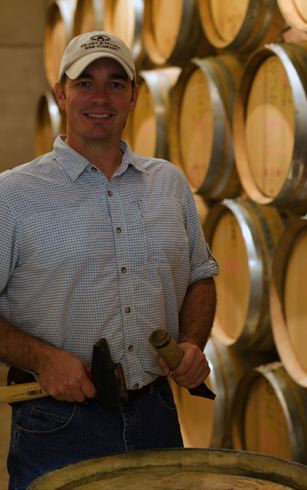
2012 Heart & Hands Finger Lakes Pinot Noir 12.4% alc., 714 cases, $23. 46% Paul’s Legacy at Hobbit Hollow Farm, 29% Elaine’s Vineyard and 25% Patrician Verona Vineyard. 50% whole cluster. · Light burnished red color in the glass. Aromas of cherry, cranberry, brioche and spice with some stem surfacing over time. Elegant in a light to mid weight style with flavors of cherry, raspberry and cinnamon spice accented with a touch of oak and underbrush. The acid spine is vibrant. This is the lightest of the wines in the 2012 lineup and shows the most oak overlay. Score: 87
2012 Heart & Hands Patrician Verona Vineyard Finger Lakes Pinot Noir 11.8% alc., 98 cases, pH 3.62, TA 0.66, $32. Vineyard is located on the western side of Cayuga Lake. Yield 3.8 tons per acre. 100% whole cluster. Unfined and unfiltered. · Light burnished red color in the glass. The nose is very appealing with scents of darker cherries, sous-bois and raw beef. A step up in concentration with generous flavors of dark cherry, blueberry and Marionberry accented by brown spices. Elegant and soft in the mouth with polished tannins and complimentary oak. When tasted the following day from a previously opened and re-corked bottle, the wine was still aromatically pleasing and showed a slight savory herb streak on the palate. Score: 89
2012 Heart & Hands Elaine’s Vineyard Finger Lakes Pinot Noir 13.0% alc., pH 3.66, TA 0.64, 96 cases, $32. Vineyard is located on the eastern shore of Seneca Lake. Yield 3.4 tons per acre. 100% whole cluster. Aged in 24% new Francois Frères French oak barrels. Unfined and unfiltered. · Light burnished red color in the glass. Vibrant aromas of fresh cherries, cola and rose petal. Very tasty mid weight flavors of cherry reduction sauce and red berry jam with a complimentary hint of spice. The tannins are well proportioned and the finish is joyous. Tasted the following day from a previously opened and re-corked bottle, the wine was still pumping out the lovely aromas and flavors indicating promising longevity. Score: 91
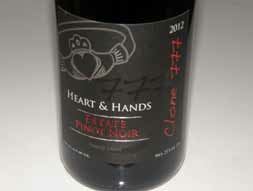 2012 Heart & Hands Estate Clone 777 Finger Lakes Pinot Noir 12.3% alc., pH 3.45, TA 0.61, 23 cases, $44. Sustainably farmed estate vineyard planted in Onondaga limestone. Yield 1.4 tons per acre. 100% whole cluster. Aged 18 months in twice-filled French oak barrels. Unfiltered. · Light garnet color in the glass. Enticing aromas of red cherry, rose petal, spice and sous-bois. Delicious light to mid weight cherry core. Very charming and soft in the mouth, with balanced tannins and a generous, lengthy finish. Tasted the following day from a previously opened and re-corked bottle, the nose was a whole cluster celebration with uplifting aromas of spice, floral bouquet and tobacco leaf. Score: 91
2012 Heart & Hands Estate Clone 828 Finger Lakes Pinot Noir 12.1% alc., pH 3.48, TA 0.59, 23 cases, $44. Yield 2.39 tons per acre. 100% whole cluster. Aged 18 months in twice-filled French oak barrels. Unfiltered. · Light garnet color in the glass. The scents of dark cherry, raspberry, blueberry, purple rose petal, forest floor and oak are repeated on the palate with some added spice. The wine is a little rugged at this point with a tug of muscular tannins that showing up on the finish. The following day when tasted from a previously opened and re-corked bottle, the aromatics were seductive with plenty of cherry and floral appeal, but the fruit was hidden by the overcoat of tannin. This wine should mellow with more time in bottle. Score: 88
2012 Heart & Hands Estate Clone 667 Finger Lakes Pinot Noir 12.3% alc., pH 3.41, TA 0.62, 23 cases, $44. Yield 1.77 tons per acre. 100% whole cluster. Aged 18 months in twice-filled French oak barrels. Unfiltered. · Moderate reddish purple color in the glass. The nose is both good and bad with fresh fruit aromas of black cherry and raspberry complimented by dark red rose petal and seasoned oak, but there is a whole cluster driven note of stem and green bean that detracts. The fruit is highly concentrated and supported by well proportioned tannins, and the mouthfeel is very polished. Should be interesting to see how this wine evolves. Score: 87-88
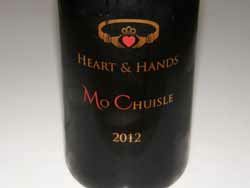 2012 Heart & Hands Mo Chuisle Finger Lakes Pinot Noir 12.6% alc., pH 3.49, TA 0.62, 147 cases, $56. Inaugural vintage from the estate vineyard. Name is Gaelic for “My Pulse” or colloquially “My Darling.” Clones are 4 (39%), 90 (22%), 115 (16%), 97 (16%) and small amounts of 667, “828” and 777. Yield 1.61 tons per acre. 100% whole cluster. Aged in 17% new French oak barrels. Unfiltered. · Moderately light reddish purple color in the glass. Bright aromas of cherry, sous-bois and raspberry. Delicious core of cherry, strawberry and raspberry fruit flavors with an undertone of earthy flora. The tannins are well balanced and the wine is quite welcoming now. The fruit is intense and tenacious on attack and finishes with aplomb and length. Impressive debut wine. Score: 93
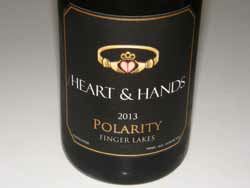 2013 Heart & Hands Polarity Finger Lakes White Wine 13.9% alc., pH 3.43, TA 0.57, 201 cases, $29. Pinot Noir grapes whole cluster pressed with minimal skin contact and fermented in French oak. Lees stirring every few days after fermentation is complete. Aged 9 months in French oak barrels. Unfined and unfiltered. · Light pinkish orange color in the glass. Lovely aromas of blood orange, peach, tropical fruits and the slightest toasty oak. The flavors follow in step with the aromas adding a touch of apricot. Bright, crisp and refreshing, with a tangy orange zest finish. This wine is a welcome change of pace from the usual white varietal suspects. Score: 90
Sips of Recently Tasted California Chardonnays
 2012 Domaine Drouhin Oregon Cuvée Limitée Dundee Hills Willamette Valley Chardonnay 14.1% alc., 149 cases, $65. Exclusively estate vineyards. Produced from some of the oldest (over 20 Years) Dijon clones on the Estate. Hand-picked, hand-sorted and pressed whole cluster. Fermented in French oak barrels ()one-third new, one-third once-used, and one-third neutral) After 11 months, the favorite barrels were selected. · Light golden yellow color in the glass. Aromatically engaging with scents of lemon drop, dried mango, golden apple and marzipan. Light on its feet, crisp and very sleek, this wine is infused with citrus and apple goodness with very little intrusion of oak. Refreshing, with some length on the bright finish. Definitely French stylistically, with a purity of fruit that is striking. One of the best Oregon Chardonnays I have experienced in recent memory. Score: 93
2012 Durant Vineyards Raven Dundee Hills Willamette Valley Chardonnay 13.5% alc., pH 3.67, 264 cases, $25. From vines planted in 1993 to clones 76 and 96. Crafted by Isabelle Dutarte of De Ponte Cellars. Harvest Brix 24.5º. Yield 2 tons per acre. · Very light golden yellow color in the glass. Aromas and flavors of apple, lemon, Asian pear, and nutty oak are offered in a bright, lighter-flavored style. Slightly soft on the palate with tight acidity and a walnut and lemon infused finish. Score: 88
2013 Meiomi California Chardonnay 13.8% alc., $19. 49% Santa Barbara County, 21% Monterey County, and 30% Sonoma County. · Pale golden yellow color in the glass. A solid offering with aromas and flavors of lemon, white peach, honey and nutty oak. Smooth on the palate, and easy to drink, with modest oak overlay, and a refreshing finish of juicy Granny Smith apples. Score: 88
2013 Rombauer Vineyards Carneros Chardonnay 14.6% alc., $32. Released August 2014. From estate vineyards and select growers including the Sangiacomo family. Very large production. Harvest Brix 22.9-25.0º. Whole cluster pressed, cold-settled overnight, racked to barrel for primary and malolactic fermentation. The lees were stirred every two weeks. Aged 8 months in 33% new French and American oak barrels. · Moderately light golden yellow color in the glass. Aromas and flavors of lemon-lime, white nectarine, vanilla, spice and buttery brioche. Mildly creamy on the palate with a subtle buttery oak compliment, and good acidity. Score: 89
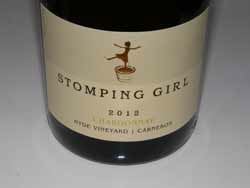 2012 Stomping Girl Hyde Vineyard Carneros Chardonnay 14.1% alc., $40. Wente and Robert Young clones. Gently whole pressed with free-run juice sent to French oak barrels (one new, the rest neutral) at a cool temperature. Aged sur lie with regular lees stirring. The wine clear naturally, without fining or filtration, and was bottled with a single racking before bottling. · Light golden yellow color in the glass. The aromas pull you into the glass, with bright notes of lemon curd, pear, toast and subtle vanilla. Delicious lemon, pear and apple flavors in a bright, crisp and clean style with a slightly creamy mouthfeel. Amazing fruit goodness. Beautifully balanced with noticeable length on the finish. All you could ask for in a Chardonnay. Drink this one on a sunny day with your best friends. Score: 94
2012 TR Elliott Three Roses Russian River Valley Chardonnay 14.5% alc., 257 cases, $32. Released May 2014. Sourced from Herrick Vineyard. Winemaker is Theodore R. Elliott. Clone 809. Aged sur lee 11 months in 30% new French oak barrels. · Moderately light golden yellow color and clear in the glass. The nose is multidimensional with aromas of lemon curd, buttery brioche, melon, and exotic floral display. Slightly creamy on the palate with flavorful notes of lemon, apple, pineapple and lemongrass. Crisp and juicy, with a deft touch of oak and appealing length on the finish. Score: 89
Pinot BriefsMillennials Intrigued by PinotFile My latest Google analytics reveal that 28% of people who land on my website are between the ages of 18 and 24, and 34% are between the ages of 25 and 34. 46% are women and 54% are men. The millennial generation (ages 21-34) consists of 70 million people and has shown the largest percentage increase in wine consumption over Gen X (ages 35-46, 44 million) and baby boomers (ages 47-64, 77 million). Baby boomers still consume 40% of wine in the U.S., while millennials account for 26%. (Figures are from Kevin Zraly, Windows on the World Complete Wine Course) By 2030, millennials will outnumber Boomers by 22 million. There is a marketing lesson here for wineries and retailers of wine who need to address the next generation of wine drinkers. A post on popdust.com by Jennifer Sales, www.popdust.com/2014/07/23/lot18-tasting-room-changing-way-wine-sold/, notes that Tasting Room by Lot18 is the fastest growing wine club in the nation since this innovative service is a hit among the millennial generation. Tasting Room sends mini tasting-size bottles of wine for members to sample and rate. Tasting Room’s algorithm makes informed wine selections for you based on your ratings. Every bottle comes with a satisfaction guarantee so that if you receive a bottle that doesn’t match your preferences, Tasting Room will replace it or issue a credit.
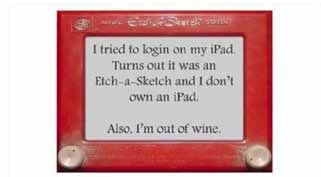 2014 Sonoma County Harvest Fair Professional Wine Competition This prestigious wine competition was held in October. Three levels of award are of particular interest. Double Gold award is a result of the unanimous decision by the panel of judges. The Best of Class award is selected from all Gold Medal award winners in every class. The Sweepstakes award is by private ballot of the judges. Pinot Noir is judged in three classes: Up to $24.99, $25 to $39.99, and $40 and over. Some of the award winners are reviewed in the next issue of the PinotFile. Best of Class, Double Gold and Sweepstakes Winning Red Wine: 2013 Balletto Vineyards & Winery BCD Vineyard Russian River Valley Pinot Noir, $42. Available on winery website at www.ballettovineyards.com. Best of Class: $25-$39.99. 2012 MacMurray Vineyards Russian River Valley Pinot Noir $28, 2013 Davis Family Vineyards Cuvée Luke Saralee’s Vineyard Russian River Valley Pinot Noir $30, and 2012 Premonition Cellars Russian River Valley Pinot Noir $34. Double Gold: 2012 D&L Carinalli Vineyards Estate Russian River Valley Pinot Noir $25, 2013 Thirty-Seven Sonoma Coast Pinot Noir $26, 2012 DRNK Cavers Cuvée Russian River Valley Pinot Noir $32, 2012 Davis Bynum Winery Jane’s Vineyard Russian River Valley Pinot Noir $35, 2013 Taft Street Garagiste Russian River Valley Pinot Noir $36, 2012 Fogline Vineyards Sun Chase Vineyard Sonoma Coast Pinot Noir $42, 2013 Balletto Sexton Hill Vineyard Russian River Valley Pinot Noir $42, 2012 Davis Family Winery Dutton Ranch Russian River Valley Pinot Noir $55. Sensor Device Useful to Monitor Your Wine Cellar FYI Devices has announced a product, that can keep your wine (and other personal belongings) safe by sending immediate notifications to people when wine gets wet or goes above or below set temperature parameters. Sensors can be placed in the cellar and provides a versatile security system without monitoring fees. Sensors are turned on and off from a users phone and alerts are sent when something changes so and response can be instituted immediately. The system provides a much larger coverage area and greater reliability than BlueTooth or WiFi. FYI sensors are available for pre-order on Indiegogo for 45 days beginning November 18. For more information, visit www.FYIdevices.com.
 “Prescription for Pinot” Published in Oregon Wine Press The latest issue features a cover story I wrote on Oregon doctors who are involved in winemaking and either winery or vineyard ownership. Read the story at www.oregonwinepress.com/doctors-prescription-pinot-oregon-wine.
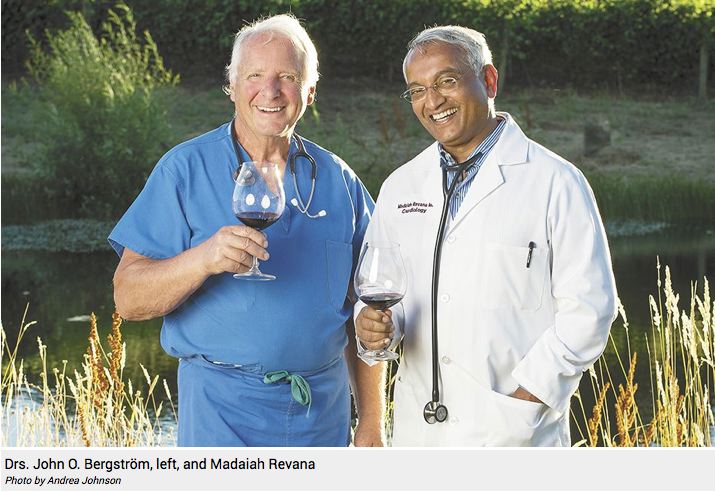 The Weather Channel Video This is a very good video that emphasizes the importance of weather in making harvest decisions, and the usefulness of The Weather channel app to winemakers. The Weather Channel strives to bring the most accurate and updated hour-by-hour weather for vineyards and their harvesting needs. Wine consumers will find it useful as well. Visit www.youtube.com/watch?v=GfyzrG4jMKY&index=8&list=PLki90Aw2GjdfKgTG7ko6s-vEhf3jdfgS1. Gabriel-Glas Release “One For All” Wine Glass Created by Swiss/German wine critic René Gabriel-Glas, this new “universal” wine glass from the Austrian company Gabriel-Glas GmbH, is said to be ideally shaped for white, red, sparkling and dessert wines. It has a broader base at the bottom of the glass, giving the wine more surface to air contact and a graceful conical shape at the top of the glass acting as a “bouquet driver.” The wine glass has been praised by several notable U.S. sommeliers who find it ideal for restaurants where a universal glass is desirable. The Gabriel-Glas is sturdy and dishwasher safe. The lead free crystal wine glass is available as a mouth-blown “Gold Edition” for $55 and the molded “StandArt” glass for $29. The glass is currently sold in retail stores in the U.S.. For more information, visit www.winegls.com.
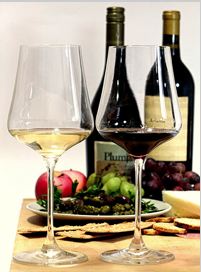 Wine Diagram Poster A valuable flow chart print that methodically records the seventeen primary varieties of red and white wine is a design by Jason Haynes, a passionate wine connoisseur. For each wine grape variety, the chart includes specific regions where it is grown, recommended glassware, best examples and a brief history. It is a plethora of information packed into a single print. A pledge on Kickstarter at https:// www.kickstarter.com/projects/haynes/wine-diagram-poster of $19 or more includes a standard-sized poster, signed and numbered with shipping included. A great Christmas gift for the wine enthusiast.
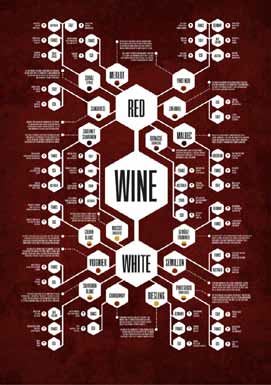 Healthy Cows Love Pinot Noir Pomace At Van Duzer Vineyards in Dallas, Oregon, over 230 tons of grapes were processed this last harvest. That means around 30 tons of pomace were left over. Some of the pomace was composted and returned to the soil as fertilizer. This year for the first time, Van Duzer send their pressings to the neighbors to feed to their yearling beef calves. The Angus beef cattle at nearby Flying F Ranch received this year’s pomace. The lucky cattle are fed livestock grain, hay and Pinot Noir grape pomace. The cattle are discriminating too, for they rejected the pressings from Pinot Gris! Studies in Australia have shown that grape pressing-fed beef ends up extra tender and well-marbled. Visit www.vanduzer.com.
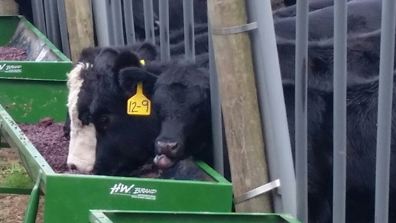 “Brown Bag Wine Tasting” Series This new Ora TV web series follows William Shatner’s adventures as he asks willing participants to blindly taste wine and describe it in terms related to their occupations. The result is a fun, interactive and social experience. The series was created out of Shatner’s love of wine as well as wanting to have a fun wine tasting experience in an entertaining format. Shatner’s first guest on the premier episode was Alton Brown who talked food, family and bubbly wine. The episodes are live on Ora.tv and Hulu.com. Click here: www.on.ora.tv/1tbLap0.com for sizzle reel and www.ora.tv/ brownbagwinetasting.com for episodes.
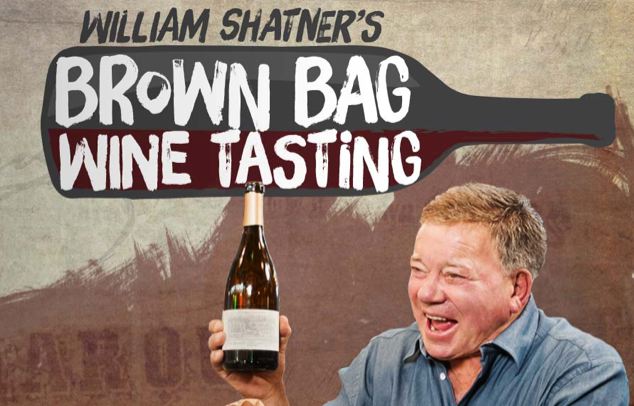 GENESIS WineStation Home Wine Preservation System This is the first single bottle preservation dispensing system designed for both still and sparkling wine. GENESIS preserves still wine for up to two months and sparkling wine or Champagne up to five days using proprietary IntelliCork Technology. Once an uncorked bottle of wine is placed in the system, oxygen is removed and replaced with WineGas, ensuring wines are kept pristine. GENESIS also dispenses preserved wine, allowing drinkers to enjoy just a glass of their favorite wine or multiple varietals at a time. Th complete system, which retails for $499 plus shipping, includes three Intellicorks, two for still wine and one for sparkling wine or Champagne, and two canisters of WineGas enough to preserve 24 bottles of wine. Visit www.genesispreserve.com. Also available at Amazon, Wine Enthusiast and Napa Styles. A PRO System is available for restaurants, wine bars and tasting rooms ($899).
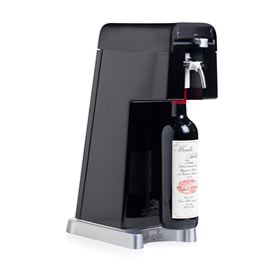 Vinotherapy New York magazine recently had an article about vinotherapy, that is, bathing in red wine. Amar’e Stoudemire, a basketball player for the New York Knicks, is one of a number of celebrities who swear by the health benefits of this practice. The claim is that the polyphenols in red wine enhance blood circulation and bestow anti-aging properties on practitioners of vinotherapy. Polyphenol researchers claim that vinotherapy is wacky and has no scientific basis. No research has been done on cutaneous absorption of wine polyphenols. I would rather just drink it. Pinot Noir-Finished Whiskey Woodford Reserve whiskey has released the ninth edition of its Master’s Collection as a whiskey finished in a Pinot Noir barrel from Sonoma-Cutrer winery. The thrice-used barrels are said to give the whiskey a fruit forward flavor. The whiskey was released in November in the U.S. with a retail price of $99 for a 750ml bottle. From www.thedrinksbusiness.com (November 20, 2014). Breeze Breathalyzer Summons Uber A Burlingame startup, Breathometer, has produced a new portable device called Breeze, that will call a ride from Uber if the user has over the legal limit of blood alcohol. The device is about 2 inches in size and pairs Bluetooth wireless technology to a smartphone app available for both iOS and Android devices. It sells for $100 on the company’s website at www.breathometer.com. West of West Orange County a Big Success! The inaugural West of West Wine Festival featuring the wines of West Sonoma County vintners, was held November 8 at the Grand Terraces Event Pavilion at the Honda Center in Anaheim, California. Over 350 people attended the event held on an unusually warm Saturday in early November. Thanks go out to the organizers and major sponsor, Orange Coast Magazine, and the participating wineries which included: 32 Winds Wine, Alma Fria, Ceritas Wines, Claypool Cellars, DuMOL Wines, Emeritus Vineyards, Ernest Vineyards, Failla Wines, Flowers Vineyard & Winery, Fort Ross Vineyard & Winery, Freeman Vineyard & Winery, Gros Ventre Cellars, Hartford Family Winery, Joseph Phelps Vineyards, LaRue Wines, Lattanzio Wines, Littorai Wines, Martinelli Winery, Paul Hobbs Winery, Peay Vineyards, Ramey Wine Cellars, Red Car Wine, Senses Wines, Siduri, Small Vines Wines, Sojourn Cellars, Soliste, Wayfarer and Zepaltas Wines. Photo below shows me at the event with a bevy of beauties including Julia of DuMOL, Kathryn of Small Vines, and Alexandra of Ramey Wine Cellars. Sunglasses were required wear on this sunny day!
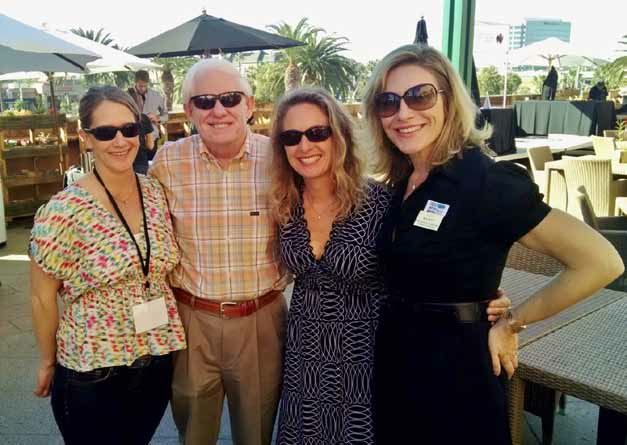
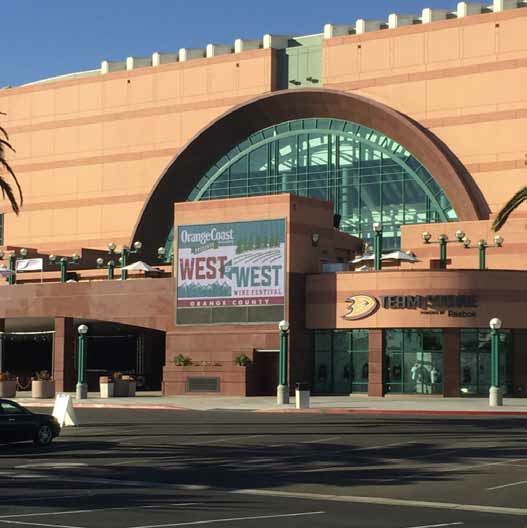
Kevin Zraly Windows on the World Complete Wine Course
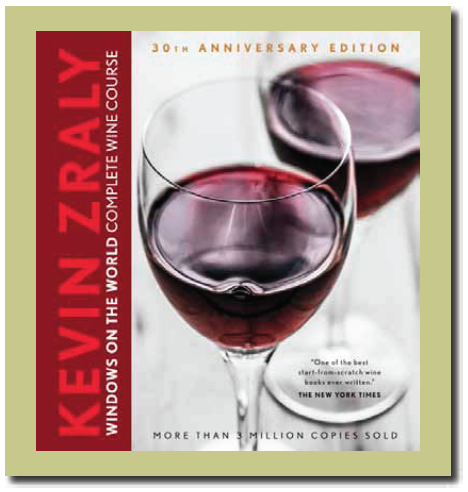 This 30th Anniversary Edition of Kevin Zraly Windows on the World Complete Wine Course reflects the remarkable longevity of this book that is the all-time bestselling guide to wine with over 3 million copies sold. I cut my teeth on this book many years ago when pursuing my early thirst for wine knowledge, and have referred to it frequently since then. Zraly became the cellar master at the newly opened Windows on the World restaurant at One World Trade Center in 1976, and ran the Windows on the World Wine Course there until September 11, 2001. His book was first published in 1985, and since then he has been recognized as one of the most influential wine educators in the world, having received a James Beard Award for the Wine & Spirits Professional of the Year. This revised 30th anniversary edition is completely redesigned and updated with an added section on his personal remembrances of Windows on the World. This is the definitive book for learning the basics of wine, and includes chapters on demystifying wine, the varieties and types of wine and how they are produced, and recommended wines and values and where to locate them. The text is peppered with hundreds of instructive labels and QR codes that allow one to access additional pronunciation guides, videos of Zraly teaching about wine, and online sources of the wines mentioned. The strength of the book lies in its succinctness and the sidebars that contain nuggets of information that emphasize points and anecdotes, and offer valuable personal commentary. Also included is a suggested format for tasting wines featured in the book, and answers to frequently asked questions about wine. This is a valuable reference book for beginners, intermediate wine knowledgeable consumers, and even well-versed wine geeks. Hardback, 368 pages, published October 2014, available widely, SRP $27.95. |